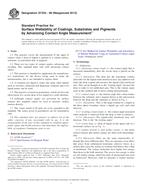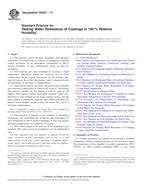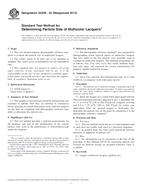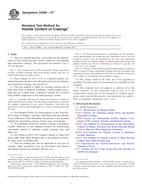Potrebujeme váš súhlas na využitie jednotlivých dát, aby sa vám okrem iného mohli ukazovať informácie týkajúce sa vašich záujmov. Súhlas udelíte kliknutím na tlačidlo „OK“.
ASTM D7334-08(2013)
Standard Practice for Surface Wettability of Coatings, Substrates and Pigments by Advancing Contact Angle Measurement
Automaticky preložený názov:
Štandardné praktiky pre zmáčavosť náterových hmôt, substrátov a pigmenty postupujúcou Meranie kontaktný uhol
NORMA vydaná dňa 1.6.2013
Informácie o norme:
Označenie normy: ASTM D7334-08(2013)
Poznámka: NEPLATNÁ
Dátum vydania normy: 1.6.2013
Kód tovaru: NS-38215
Počet strán: 3
Približná hmotnosť: 9 g (0.02 libier)
Krajina: Americká technická norma
Kategória: Technické normy ASTM
Kategórie - podobné normy:
Anotácia textu normy ASTM D7334-08(2013) :
Keywords:
advancing contact angles, contact angles, surface tensions, wettability, wettings, ICS Number Code 87.040 (Paints and varnishes)
Doplňujúce informácie
| Significance and Use | ||||
|
5.1 This standard is useful for characterizing the wettability of surfaces. A surface that is easy to wet is one over which a coating is more likely to give good adhesion and appearance and less likely to suffer surface tension related defects such as crawling, cratering, pinholing and orange peel. 5.2 This standard also can be used to test pigment surfaces for wettability, particularly by potential surfactant- or resin-based dispersants or mill bases. Easily wetted pigments are more likely to be easy to disperse and dispersants/mill bases that wet pigments of interest are more likely to disperse those pigments well. 5.3 Although the contact angle is governed by the surface tensions of the test liquid and test surface, the angle cannot provide a surface tension value directly. 5.4 A low advancing contact angle value (<45°) is indicative of wetting and angles of 10 to 20º are indicative of excellent wetting. 5.5 Water can be used as a test liquid to establish (via the advancing contact angle) whether a surface is hydrophilic (angle <45º), hydrophobic (angle > 90º) or somewhere in-between (angle of 45 to 90º). Water contact angles have been used to estimate surface cleanliness before and after cleaning operations, ease of wettability of surfaces by waterborne coatings and the effectiveness of rinsing processes. 5.6 An organic liquid such as a solvent also can be used to characterize a substrate, coating or pigment. The resultant contact angle will depend on the surface tensions of the liquid and the test surface. A low surface tension (energy) test surface will not be wet by a high surface tension liquid. 5.7 In addition to water and solvents, a surfactant dispersion or dispersant solution can be used to test a pigment surface. Any test liquid that is a potential dispersant for a test pigment must wet the pigment well or it will not work as a dispersant. 5.8 Contact angle measurements can be used to map surfaces in terms of hydrophilicity, presence of low surface tension components or contaminants, or variations in composition. Other analytical methods such as infrared microscopy would be needed to identify the chemical moieties that give the contact angle differences. 5.9 This test method can be used on nearly all coatings and substrates and may be extended to pigments by compressing the pigment powder into a solid disk. |
||||
| 1. Scope | ||||
|
1.1 This practice covers the measurement of the angle of contact when a drop of liquid is applied to a coated surface, substrate, or preformed disk of pigment. 1.2 There are two types of contact angles, advancing and receding. This standard deals only with advancing contact angles. 1.3 This practice is intended to supplement the manufacturer’s instructions for the device being used to make the measurements, but is not intended to replace them. 1.4 A common test liquid is water, but many other liquids such as solvents, surfactant and dispersant solutions and even liquid paints can be used. 1.5 This practice is based on goniometry, which involves the observation of a sessile drop of test liquid on a solid substrate. 1.6 Although contact angles are governed by surface tension, this standard cannot be used to measure surface tension directly. 1.7 The values stated in SI units are to be regarded as the standard. The values given in parentheses are for information only. 1.8 This standard does not purport to address all of the safety concerns, if any, associated with its use. It is the responsibility of the user of this standard to establish appropriate safety and health practices and determine the applicability of regulatory limitations prior to use. |
||||
| 2. Referenced Documents | ||||
|
Podobné normy:
Historická
1.6.2011
Historická
1.2.2011
Historická
1.6.2013
Historická
1.2.2010
Historická
1.6.2013
Historická
1.7.2011



 ASTM D2245-90(2011)..
ASTM D2245-90(2011).. ASTM D2247-11
ASTM D2247-11 ASTM D2248-01a(2013)..
ASTM D2248-01a(2013).. ASTM D2337-01(2010)..
ASTM D2337-01(2010).. ASTM D2338-02(2013)..
ASTM D2338-02(2013).. ASTM D2369-10e1
ASTM D2369-10e1
 Cookies
Cookies
